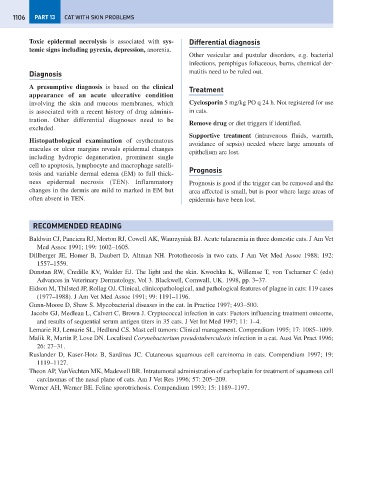Page 1114 - Problem-Based Feline Medicine
P. 1114
1106 PART 13 CAT WITH SKIN PROBLEMS
Toxic epidermal necrolysis is associated with sys- Differential diagnosis
temic signs including pyrexia, depression, anorexia.
Other vesicular and pustular disorders, e.g. bacterial
infections, pemphigus foliaceous, burns, chemical der-
Diagnosis matitis need to be ruled out.
A presumptive diagnosis is based on the clinical
Treatment
appearance of an acute ulcerative condition
involving the skin and mucous membranes, which Cyclosporin 5 mg/kg PO q 24 h. Not registered for use
is associated with a recent history of drug adminis- in cats.
tration. Other differential diagnoses need to be
Remove drug or diet triggers if identified.
excluded.
Supportive treatment (intravenous fluids, warmth,
Histopathological examination of erythematous
avoidance of sepsis) needed where large amounts of
macules or ulcer margins reveals epidermal changes
epithelium are lost.
including hydropic degeneration, prominent single
cell to apoptosis, lymphocyte and macrophage satelli-
Prognosis
tosis and variable dermal edema (EM) to full thick-
ness epidermal necrosis (TEN). Inflammatory Prognosis is good if the trigger can be removed and the
changes in the dermis are mild to marked in EM but area affected is small, but is poor where large areas of
often absent in TEN. epidermis have been lost.
RECOMMENDED READING
Baldwin CJ, Panciera RJ, Morton RJ, Cowell AK, Waurzyniak BJ. Acute tularaemia in three domestic cats. J Am Vet
Med Assoc 1991; 199: 1602–1605.
Dillberger JE, Homer B, Daubert D, Altman NH. Protothecosis in two cats. J Am Vet Med Assoc 1988; 192:
1557–1559.
Dunstan RW, Credille KV, Walder EJ. The light and the skin. Kwochka K, Willemse T, von Tscharner C (eds)
Advances in Veterinary Dermatology, Vol 3. Blackwell, Cornwall, UK. 1998, pp. 3–37.
Eidson M, Thilsted JP, Rollag OJ. Clinical, clinicopathological, and pathological features of plague in cats: 119 cases
(1977–1988). J Am Vet Med Assoc 1991; 99: 1191–1196.
Gunn-Moore D, Shaw S. Mycobacterial diseases in the cat. In Practice 1997; 493–500.
Jacobs GJ, Medleau L, Calvert C, Brown J. Cryptococcal infection in cats: Factors influencing treatment outcome,
and results of sequential serum antigen titers in 35 cats. J Vet Int Med 1997; 11: 1–4.
Lemarie RJ, Lemarie SL, Hedlund CS. Mast cell tumors: Clinical management. Compendium 1995; 17: 1085–1099.
Malik R, Martin P, Love DN. Localised Corynebacterium pseudotuberculosis infection in a cat. Aust Vet Pract 1996;
26: 27–31.
Ruslander D, Kaser-Hotz B, Sardinas JC. Cutaneous squamous cell carcinoma in cats. Compendium 1997; 19:
1119–1127.
Theon AP, VanVechten MK, Madewell BR. Intratumoral administration of carboplatin for treatment of squamous cell
carcinomas of the nasal plane of cats. Am J Vet Res 1996; 57: 205–209.
Werner AH, Werner BE. Feline sporotrichosis. Compendium 1993; 15: 1189–1197.

